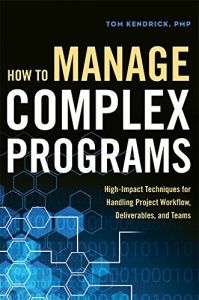Join getAbstract to access the summary!

Join getAbstract to access the summary!
Tom Kendrick
How to Manage Complex Programs
High-Impact Techniques for Handling Project Workflow, Deliverables, and Teams
AMACOM, 2016
What's inside?
Enter the field of “complex program management” with planning expert Tom Kendrick.
Recommendation
Former Hewlett-Packard program planner Tom Kendrick, now a program director for project management and agile management at UC Berkeley, invites you onto his “complex program management” playing field. He breaks this process down into manageable parts, from “program initiation” to “program closure.” He calls upon his experience at HP to brighten your journey with examples, templates and lessons learned. Kendrick offers excellent preparation for mastering complex programs, though some lengthy chapters are a challenge. getAbstract recommends his manual to project managers looking to become program managers, to program managers seeking more input and to line managers interested in a career development challenge.
Summary
About the Author
Tom Kendrick, a former program planner at Hewlett-Packard, is now program director for project management and agile management at UC Berkeley.


















Comment on this summary